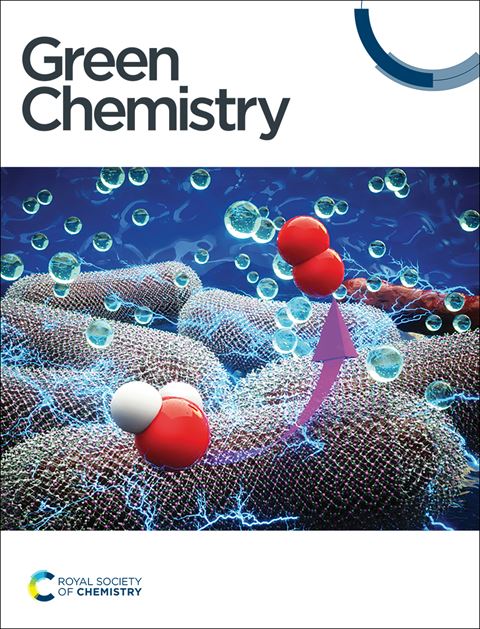Organocatalytic aqueous formulations: green organocatalytic hydrophobization of heterogeneous polysaccharide-based materials in water through “on-water” mechanisms†
IF 9.3
1区 化学
Q1 CHEMISTRY, MULTIDISCIPLINARY
引用次数: 0
Abstract
A concept for developing stable, water-based colloids for simple, effective, green, and organocatalytic hydrophobization of heterogeneous polysaccharide-based materials (e.g., cellulose, wood, and paper) in water is disclosed. The addition of a surfactant, an organocatalyst, and a hydrophobic agent (e.g., alkyl trialkoxysilane) to water results in organocatalytic polymerization and the formation of a water-based suspension, which, upon homogenization, forms a stable colloid. The mechanism for the generation of this organocatalytic aqueous formulation (OAF) is elucidated by microscopy and spectroscopy. It is initiated by organocatalytic alkyl alkoxysilane polymerization within the nanomicelles formed by the surfactant in water through an “on-water” Type IIa mechanism. Next, these micelles expand to a microsize upon further polymerization, eventually leading to aggregation and the formation of a suspension through an “on-water” Type III mechanism. Homogenizing this suspension yields a stable colloid with water as the medium. The OAFs were then applied to various cellulosic substrates (e.g., cellulose paper, paper sheets, cotton, and wood) by spraying, roll-coating, or dipping. Organocatalytic colloidal particle modification of a wide range of cellulosic substrates (e.g. paper, cotton, and wood) in water through an “on-water” mechanism, which we here classify as Type IV, results in hydrophobic (contact angles of >145°) or superhydrophobic (contact angles of >150°) cellulosic surfaces. Thus, the OAFs can be utilized for modifying a wide range of industrially relevant cellulose-based materials under eco-friendly conditions. The dual role of the organocatalyst in mediating colloidal particle formation and green hydrophobic modification of heterogeneous polysaccharides exemplifies a novel approach for harnessing the catalytic potential of small molecules for organic reactions in water.
有机催化水性配方:通过“on-water”机制在水中对多相多糖基材料进行绿色有机催化疏水
公开了一种用于开发稳定的水基胶体的概念,用于在水中对多相多糖基材料(例如纤维素、木材和纸)进行简单、有效、绿色和有机催化疏水。在水中加入表面活性剂、有机催化剂和疏水剂(如烷基三烷氧基硅烷),可产生有机催化聚合并形成水基悬浮液,该悬浮液经均质化后形成稳定的胶体。用显微镜和光谱学方法研究了该有机催化水溶液(OAF)的生成机理。它是由表面活性剂在水中形成的纳米胶束内的有机催化烷基烷氧基硅烷聚合,通过“对水”IIa型机理引发的。接下来,这些胶束在进一步聚合后扩展到微观尺寸,最终通过“在水”III型机制导致聚集并形成悬浮液。均质化这种悬浮液,以水为介质得到稳定的胶体。然后通过喷涂、滚涂或浸渍将oaf应用于各种纤维素基材(例如,纤维素纸、纸片、棉花和木材)。有机催化胶体颗粒在水中通过“水上”机制对多种纤维素基质(如纸、棉花和木材)进行改性,我们在此将其归类为IV型,可产生疏水(接触角为145°)或超疏水(接触角为150°)纤维素表面。因此,oaf可用于在环保条件下对广泛的工业相关纤维素基材料进行改性。有机催化剂在介导胶体颗粒形成和多相多糖绿色疏水改性中的双重作用,为利用小分子催化潜力在水中进行有机反应提供了一种新方法。
本文章由计算机程序翻译,如有差异,请以英文原文为准。
求助全文
约1分钟内获得全文
求助全文
来源期刊

Green Chemistry
化学-化学综合
CiteScore
16.10
自引率
7.10%
发文量
677
审稿时长
1.4 months
期刊介绍:
Green Chemistry is a journal that provides a unique forum for the publication of innovative research on the development of alternative green and sustainable technologies. The scope of Green Chemistry is based on the definition proposed by Anastas and Warner (Green Chemistry: Theory and Practice, P T Anastas and J C Warner, Oxford University Press, Oxford, 1998), which defines green chemistry as the utilisation of a set of principles that reduces or eliminates the use or generation of hazardous substances in the design, manufacture and application of chemical products. Green Chemistry aims to reduce the environmental impact of the chemical enterprise by developing a technology base that is inherently non-toxic to living things and the environment. The journal welcomes submissions on all aspects of research relating to this endeavor and publishes original and significant cutting-edge research that is likely to be of wide general appeal. For a work to be published, it must present a significant advance in green chemistry, including a comparison with existing methods and a demonstration of advantages over those methods.
 求助内容:
求助内容: 应助结果提醒方式:
应助结果提醒方式:


